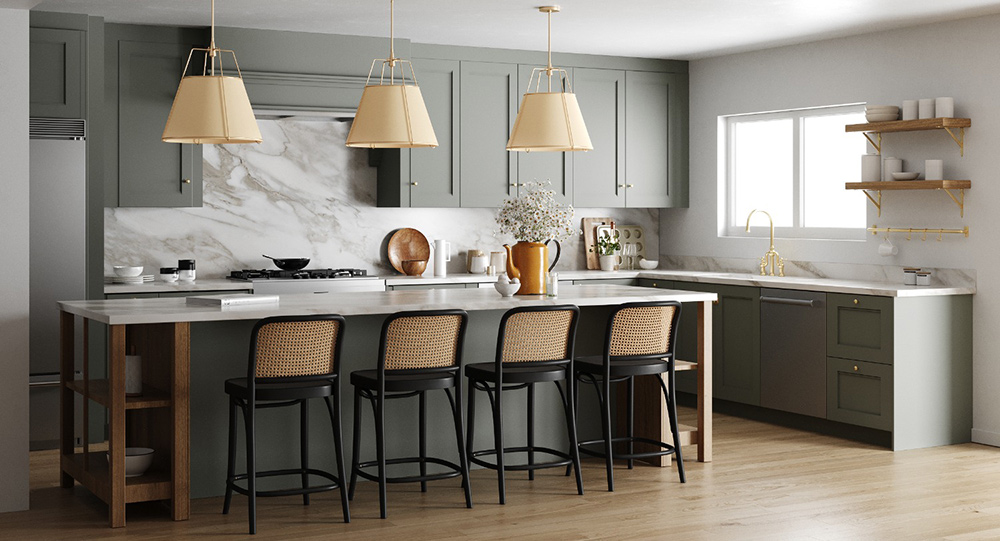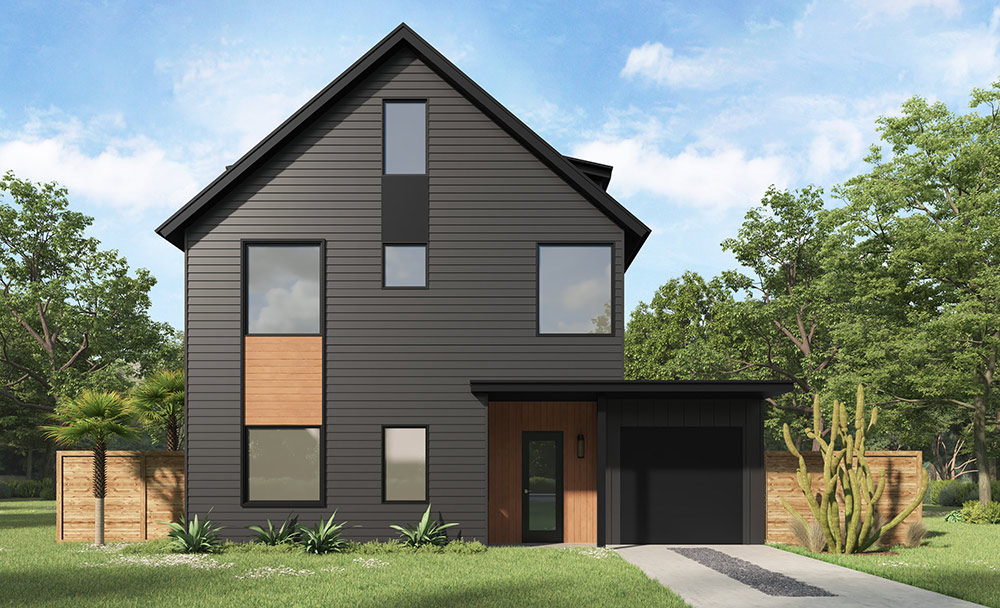美国HGTV频道的节目让房屋装修看起来轻而易举。但实际上,从重新设计厨房、装修新洗手间或者从零开始新建一栋房子,都是一个复杂且漫长的过程,通常要有多方专业人员花费几个月进行协调,需要投入数万美元,还要遵守大量复杂的建筑法规和许可。
随着人工智能的出现,房屋的装修过程变得更快、更简单、成本更低,甚至更可持续。
端对端装修服务提供商Skipp的联合创始人及首席执行官伊恩·贾弗里说:“房屋装修会给人们留下许多可怕的回忆,如果找不到恰当的专业服务,人们就会遇到各种问题。我们利用科技,向客户提供非常精确的装修方案。这让整个装修过程变得更简单,使人们可以专注于灵感、透明度和预算。”
Skipp采用人工智能技术编制、分析和推荐房屋装修方案。该公司目前的业务重点是厨房装修,而这也是房屋装修中最具有挑战性的一个房间。首先,该公司使用3D摄像机精准测量房屋尺寸,并将这些信息添加到系统。系统内置的人工智能会跟踪必要信息,例如天然气管线布置、卫生管道布置、窗户以及建筑法规与标准等。然后,系统会根据业主的要求,比如优化储物或娱乐空间等,开始利用算法进行计算。

通过使用人工智能技术,Skipp能够很快根据空间的限制条件量身定制多种不同方案,向业主展示符合其要求的可行的房间布局和模型。之后,该公司会为业主联系相关领域的承包商,承包商收到需求建议书和设计要素后将开始施工。贾弗里表示,业主可以专注于“灵感方面”,例如橱柜、门把手和厨房台面材料等,不必再纠结于建筑图纸和承包商的行话这些问题。
对于一间10×10英尺的厨房,Skipp通常会提出700种不同空间布置方案。贾弗里指出,有的厨房只需要一周的时间就能够完成施工。
如果没有人工智能,一间完整厨房的施工过程就需要耗费更多的人力。贾弗里称,设计师测量房间尺寸、绘制示意图草案以及准备不同布局方案,可能需要多达70个小时。之后还要向承包商协商报价和时间安排。贾弗里解释道,厨房装修平均耗时长达9至12个月。而通过使用Skipp提供的服务,业主只需要45天就可以拥有一间新厨房。他补充说:“没有人想花一年时间设计一间厨房。”
Skipp通过简化装修过程,还降低了整体成本。贾弗里表示,在Skipp总部所在的纽约市,厨房的平均装修成本为12万美元。而通过Skipp,装修成本能够降低到约35000美元,因为它节省了建筑师、设计师和承包商的时间。
与其他类型的人工智能一样,随着用户增多,Skipp系统将变得更智能。随着越来越多的业主选择最符合预算和储物要求的方案,该系统将学会用户常选的组合,并推荐给未来的业主。随着不断学习,系统还将提高推荐速度。贾弗里和他的团队希望将Skipp打造成一款实时家装手机应用程序,可以直接扫描房间,在几分钟后就能够给出布局和设计方案。

不止Skipp一家公司在将人工智能应用于住宅领域。Higharc和Homebound等主营建筑施工的公司也在努力简化建模过程,为业主寻找建筑师、设计师和承包商等专业人员提供便利,最终使更多的人有机会拥有住房。这对于千禧一代尤其重要,目前50%的购房者是千禧一代。他们发现拥有住房的过程充满了挑战。贾弗里表示,美国80%的住房房龄超过20年,这意味着一个庞大的房屋装修市场。
还有许多人计划建房。迈克尔·伯金参与创建的Higharc公司可以帮助降低建房过程的复杂性。作为设计创新总监,他把公司的产品比喻成现代化的汽车配置器。客户能够直观地看到数百种房屋选项,包括实时定价,保证了交易过程的透明度。与Skipp一样,Higharc用人工智能系统取代了需要耗时数小时的人工操作,该系统可以输出房屋布局、家电方案和其他设计要素等,并保证完全符合建筑法规。
伯金表示:“以前几乎每一栋建筑都需要从零开始进行设计。其他项目中的知识很难直接照搬。而Higharc使用知识库捕捉和重复使用数据,并持续改进该系统创建的房屋的方案和质量。”
除此之外,伯金指出,Higharc可靠的3D模型发现了一个令人意外的统计数据:由于测量错误,一栋房屋的建筑商浪费了高达25%的木材,而Higharc通过人工智能技术能够避免出现这种问题。这不仅可以节约成本,还能够做到环保。
Homebound的业务类似,但其主要从事大规模住宅建设。2017年加州野火发生后不久,当地居民迫切需要新房,Homebound的首席执行官及联合创始人尼基·佩赫特当时成立了这家公司。该公司提供的服务类似于电商服务,购房人可以在一个网站上选择房屋的地块、平面图、建筑风格和装饰装修等。在这个过程中,该技术平台会评估一系列数据,以简化设计和建筑过程。佩赫特表示,与传统大规模房屋建设项目相比,Homebound在设计阶段的效率提高了8倍,施工速度提高了20%。
Homebound也为房屋开放商提供了协助。其数据库中涵盖了超过2500万套住房,并且数量仍然在不断增加。佩赫特的团队训练了可靠的算法,用于模拟地块购买成本、预期建筑成本和房屋完工后的预期售价,以预测大规模房地产开发的可行性。
佩赫特称:“房屋建筑信息数量庞大,只有人工智能和机器学习能够从不同项目、地区和市场中总结出规律。”她还表示,这对于规模达到约1.5万亿美元的房屋建筑行业具有巨大的影响。
道格·维克尔森是企业可视化平台Renoworks的首席执行官。该平台服务承包商及其客户。维克尔森将其比作亚马逊(Amazon)。现在消费者已经习惯了用更短时间购买商品和服务;因此人们自然也希望房屋装修过程变得比传统装修过程更迅速,这并不意外。Renoworks已经有20年的历史。维克尔森发现,对于人工智能和机器学习技术提供的功能和效率,人们的需求日益增加。
他表示,为了适应这种趋势,Renoworks的技术堆栈和基础设施进行了升级。与佩赫特、贾弗里和伯金一样,维克尔森也认为针对住宅建设面临的诸多挑战,人工智能就是解决方案。
他说:“人工智能的目标是省略额外的步骤,避免麻烦的决策,从而帮助消费者专注于重要的事情,并帮助行业简化对设计方案的解释。人工智能正在帮助我们准确预测客户的偏好,从而避免决策过程中的所有麻烦。在房屋装修领域,人工智能的应用仍然处在初期阶段,但未来有无数的可能性。”(财富中文网)
译者:刘进龙
审校:汪皓
美国HGTV频道的节目让房屋装修看起来轻而易举。但实际上,从重新设计厨房、装修新洗手间或者从零开始新建一栋房子,都是一个复杂且漫长的过程,通常要有多方专业人员花费几个月进行协调,需要投入数万美元,还要遵守大量复杂的建筑法规和许可。
随着人工智能的出现,房屋的装修过程变得更快、更简单、成本更低,甚至更可持续。
端对端装修服务提供商Skipp的联合创始人及首席执行官伊恩·贾弗里说:“房屋装修会给人们留下许多可怕的回忆,如果找不到恰当的专业服务,人们就会遇到各种问题。我们利用科技,向客户提供非常精确的装修方案。这让整个装修过程变得更简单,使人们可以专注于灵感、透明度和预算。”
Skipp采用人工智能技术编制、分析和推荐房屋装修方案。该公司目前的业务重点是厨房装修,而这也是房屋装修中最具有挑战性的一个房间。首先,该公司使用3D摄像机精准测量房屋尺寸,并将这些信息添加到系统。系统内置的人工智能会跟踪必要信息,例如天然气管线布置、卫生管道布置、窗户以及建筑法规与标准等。然后,系统会根据业主的要求,比如优化储物或娱乐空间等,开始利用算法进行计算。
通过使用人工智能技术,Skipp能够很快根据空间的限制条件量身定制多种不同方案,向业主展示符合其要求的可行的房间布局和模型。之后,该公司会为业主联系相关领域的承包商,承包商收到需求建议书和设计要素后将开始施工。贾弗里表示,业主可以专注于“灵感方面”,例如橱柜、门把手和厨房台面材料等,不必再纠结于建筑图纸和承包商的行话这些问题。
对于一间10×10英尺的厨房,Skipp通常会提出700种不同空间布置方案。贾弗里指出,有的厨房只需要一周的时间就能够完成施工。
如果没有人工智能,一间完整厨房的施工过程就需要耗费更多的人力。贾弗里称,设计师测量房间尺寸、绘制示意图草案以及准备不同布局方案,可能需要多达70个小时。之后还要向承包商协商报价和时间安排。贾弗里解释道,厨房装修平均耗时长达9至12个月。而通过使用Skipp提供的服务,业主只需要45天就可以拥有一间新厨房。他补充说:“没有人想花一年时间设计一间厨房。”
Skipp通过简化装修过程,还降低了整体成本。贾弗里表示,在Skipp总部所在的纽约市,厨房的平均装修成本为12万美元。而通过Skipp,装修成本能够降低到约35000美元,因为它节省了建筑师、设计师和承包商的时间。
与其他类型的人工智能一样,随着用户增多,Skipp系统将变得更智能。随着越来越多的业主选择最符合预算和储物要求的方案,该系统将学会用户常选的组合,并推荐给未来的业主。随着不断学习,系统还将提高推荐速度。贾弗里和他的团队希望将Skipp打造成一款实时家装手机应用程序,可以直接扫描房间,在几分钟后就能够给出布局和设计方案。
不止Skipp一家公司在将人工智能应用于住宅领域。Higharc和Homebound等主营建筑施工的公司也在努力简化建模过程,为业主寻找建筑师、设计师和承包商等专业人员提供便利,最终使更多的人有机会拥有住房。这对于千禧一代尤其重要,目前50%的购房者是千禧一代。他们发现拥有住房的过程充满了挑战。贾弗里表示,美国80%的住房房龄超过20年,这意味着一个庞大的房屋装修市场。
还有许多人计划建房。迈克尔·伯金参与创建的Higharc公司可以帮助降低建房过程的复杂性。作为设计创新总监,他把公司的产品比喻成现代化的汽车配置器。客户能够直观地看到数百种房屋选项,包括实时定价,保证了交易过程的透明度。与Skipp一样,Higharc用人工智能系统取代了需要耗时数小时的人工操作,该系统可以输出房屋布局、家电方案和其他设计要素等,并保证完全符合建筑法规。
伯金表示:“以前几乎每一栋建筑都需要从零开始进行设计。其他项目中的知识很难直接照搬。而Higharc使用知识库捕捉和重复使用数据,并持续改进该系统创建的房屋的方案和质量。”
除此之外,伯金指出,Higharc可靠的3D模型发现了一个令人意外的统计数据:由于测量错误,一栋房屋的建筑商浪费了高达25%的木材,而Higharc通过人工智能技术能够避免出现这种问题。这不仅可以节约成本,还能够做到环保。
Homebound的业务类似,但其主要从事大规模住宅建设。2017年加州野火发生后不久,当地居民迫切需要新房,Homebound的首席执行官及联合创始人尼基·佩赫特当时成立了这家公司。该公司提供的服务类似于电商服务,购房人可以在一个网站上选择房屋的地块、平面图、建筑风格和装饰装修等。在这个过程中,该技术平台会评估一系列数据,以简化设计和建筑过程。佩赫特表示,与传统大规模房屋建设项目相比,Homebound在设计阶段的效率提高了8倍,施工速度提高了20%。
Homebound也为房屋开放商提供了协助。其数据库中涵盖了超过2500万套住房,并且数量仍然在不断增加。佩赫特的团队训练了可靠的算法,用于模拟地块购买成本、预期建筑成本和房屋完工后的预期售价,以预测大规模房地产开发的可行性。
佩赫特称:“房屋建筑信息数量庞大,只有人工智能和机器学习能够从不同项目、地区和市场中总结出规律。”她还表示,这对于规模达到约1.5万亿美元的房屋建筑行业具有巨大的影响。
道格·维克尔森是企业可视化平台Renoworks的首席执行官。该平台服务承包商及其客户。维克尔森将其比作亚马逊(Amazon)。现在消费者已经习惯了用更短时间购买商品和服务;因此人们自然也希望房屋装修过程变得比传统装修过程更迅速,这并不意外。Renoworks已经有20年的历史。维克尔森发现,对于人工智能和机器学习技术提供的功能和效率,人们的需求日益增加。
他表示,为了适应这种趋势,Renoworks的技术堆栈和基础设施进行了升级。与佩赫特、贾弗里和伯金一样,维克尔森也认为针对住宅建设面临的诸多挑战,人工智能就是解决方案。
他说:“人工智能的目标是省略额外的步骤,避免麻烦的决策,从而帮助消费者专注于重要的事情,并帮助行业简化对设计方案的解释。人工智能正在帮助我们准确预测客户的偏好,从而避免决策过程中的所有麻烦。在房屋装修领域,人工智能的应用仍然处在初期阶段,但未来有无数的可能性。”(财富中文网)
译者:刘进龙
审校:汪皓
HGTV shows make home renovations look straightforward. But in reality, the process of redesigning a kitchen, installing a new bathroom, or building a home from the ground up is a complex and lengthy process—one that often takes months of coordination among several professionals, tens of thousands of dollars, and plenty of perplexing building codes and permits.
With artificial intelligence, that process is becoming faster, easier, cheaper, and possibly more sustainable.
“A lot of horror stories come up with renovations, and people encounter those problems when they don’t have the right professional service at their side,” says Ian Jaffrey, cofounder and chief executive officer of Skipp, an end-to-end renovation service. “We’re leveraging technology that is really about getting precise plans in place for customers. Doing that makes that whole process easier and allows people to focus on inspiration, transparency, and budget.”
Skipp relies on A.I. to compile, analyze, and recommend home renovation options. Today the company is focused on kitchens, which happen to be the most challenging room in the home for a remodel. It starts with a 3D camera to capture precise measurements in the room and add those points of intelligence to the system. The embedded intelligence tracks necessary information—like the placement of gas lines, plumbing, and windows—plus architectural codes and standards. Then it takes into account the homeowner’s requests, such as optimizing the space for storage or entertaining, to start to apply an algorithm.
By using A.I., Skipp quickly tailors a number of different options within the constraints of the specific space to present the homeowner with layouts and mockups that will be feasible in the room and fit their personal requirements. The service then connects homeowners with contractors in their area, who receive specific requests for proposals and design elements to start the work. Homeowners can focus on the “inspirational aspects,” says Jaffrey, such as cabinetry, door handles, and countertop materials, rather than get bogged down by building paperwork and contractor jargon.
For a 10-foot-by-10-foot kitchen, Skipp typically comes up with 700 different permutations. Jaffrey says that they have had kitchens ready to be built in as little as a week.
Without the use of A.I. technology, the journey to a completed kitchen is much more manual. Jaffrey says that it can take a designer up to 70 hours just to measure and draft schematic plans, plus entertain various configurations. And that’s before you reach out to contractors for quotes and timelines. Jaffrey explains that the average kitchen renovation takes nine to 12 months. With Skipp, homeowners can have a new kitchen in just 45 days. “No one wants to spend a year of their life planning a kitchen,” he adds.
By streamlining the process, Skipp also makes the entire renovation more accessible financially. In New York City, where Skipp is based, Jaffrey says that the average kitchen renovation is $120,000. Skipp can do it all for about $35,000, simply by reducing the amount of time it takes architects, designers, and contractors.
Like any type of A.I., the Skipp system gets smarter as more users log on. As an increasing number of homeowners select options that optimize for budget and storage, the system will learn what combinations are typically chosen, working to offer those up to future homeowners. It also learns to make recommendations more quickly. Jaffrey and his team aim for Skipp to be home renovations in real time: an instantaneous phone application that scans the room, then offers configurations and design options in mere minutes.
Skipp is not alone in its development of A.I. for homes. It joins construction-focused companies like Higharc and Homebound in its drive to simplify the modeling process, access to professionals like architects, designers, and contractors, and ultimately make housing more accessible. It’s particularly significant for the millennial population, who account for 50% of current home purchases. They have largely found the homeowning experience to be rife with challenges. According to Jaffrey, 80% of the homes in the U.S. are more than 20 years old, which opens a large market for home renovations.
Then there are those looking to build a home. Michael Bergin cofounded Higharc to help reduce the complexity of the homebuilding process. As the director of design innovation, he likens his product to a modern car configurator. Buyers can visualize hundreds of home options with real-time pricing for instant transparency. Like Skipp, Higharc replaces hours of manual drafting with an A.I. system to export layouts, appliance options, and other design elements, all while maintaining compliance with the nuances of building codes.
“Buildings in the past were designed from scratch in nearly every case,” Bergin says. “Carrying knowledge through projects was impossible. Higharc uses a knowledge base to capture and reuse data and continuously improve the options and quality of the homes created in the system.”
In an added benefit, Bergin says that Higharc’s reliable 3D model revealed a surprising statistic: Builders wasted up to 25% of the lumber ordered for a home due to errors in measurement, a hurdle that Higharc avoids thanks to A.I. That’s not only a cost savings, but an environmental one too.
Homebound is doing something similar, but for homes at scale. CEO and cofounder Nikki Pechet launched Homebound in the wake of the 2017 wildfires in California, when residents in the area needed new homes quickly. The service works like an e-commerce experience in which buyers can select a lot, floor plan, architectural style, and finishes all through one online portal. In the process, the technology platform amassed a serious amount of data to streamline the design and building process. Pechet says that Homebound is eight times more efficient in the design phase, and construction moves 20% faster than traditional large-scale home construction projects.
It has also aided home developers. Homebound has a growing database of more than 25 million properties. Pechet’s team has trained robust algorithms to model out the site acquisition cost, expected built costs, and expected sell prices of finished homes to forecast the feasibility of large-scale property development.
“The volume of homebuilding information is so large that only A.I. and machine learning can see patterns across projects, jurisdictions, and marketplaces,” Pechet says. That’s hugely impactful for an industry worth an estimated $1.5 trillion, she adds.
Doug Vickerson, chief executive officer of Renoworks, an enterprise visualization platform for contractors and respective clients, compares it all to Amazon. Consumers are now accustomed to having goods and services fulfilled in less time; it’s no surprise that they want their home renovations to move along more swiftly than the traditional process. Renoworks has been in the business for two decades, and over this time, Vickerson has seen an increased demand for functionality and speed that only technology like A.I. and machine learning can provide.
Technically, he says, Vickerson has updated the Renoworks tech stack and infrastructure to reflect this. For him, like Pechet, Jaffrey, and Bergin, A.I. is the solution to the challenges of residential home construction.
“The goal of A.I. is to help consumers focus on the important matters by eliminating extra steps and cumbersome decisions, and help the industry streamline interpretation,” Vickerson says. “A.I. is helping us move toward predicting preferences so accurately that it eliminates all fiction in the decision-making. A.I. in home renovations is early, but the possibilities are there.”






